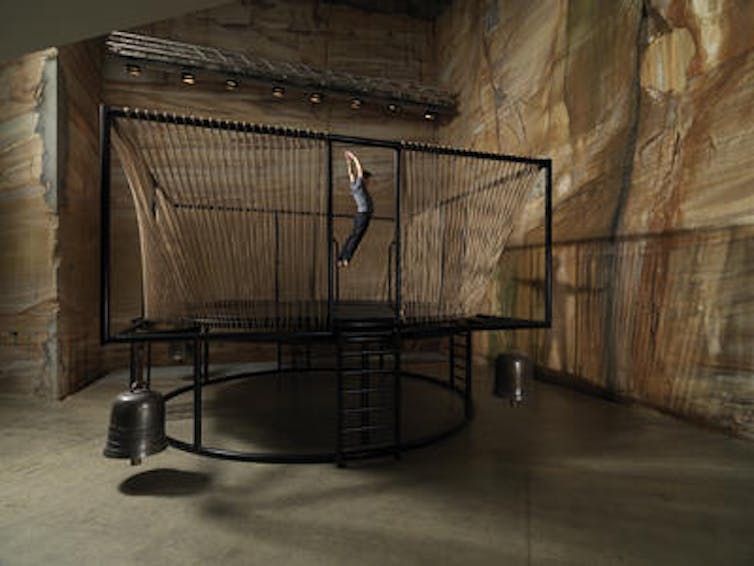A column of light shines from Hobart’s Queen’s Domain, where Japanese artist Ryoji Ikeda’s Spectra reaches up to the looming clouds, visible across the city. The normally empty streets are crowded, the ever more posh restaurants full, as the Dark MOFO festival - the evil twin of high summer’s MONA FOMA (Museum of Old and New Art’s Festival Of Music and Art) - takes centre stage. Ten days of music, performance, film, visual art and food has transformed Hobart’s winter season.
The festival is part of a wider transformation brought on by the arrival of MONA – Museum of Old and New Arts – into the suburban, working class city of Glenorchy in early 2011. Taxi drivers are enthused by the surge in visitors - though there are still too many taxis, apparently.
Senior state politicians talk about a new golden age. Officials trumpet the 40% rise in flights to Hobart in the last year. Local hipsters are savouring the chance to roll their eyes at the “Melbourne types” who now clog up all the venues. Chance conversations in pubs, hotels and shops suggest a new sense of excitement for the future.
The man behind the movement
Hobart was never a blank canvas yet everybody understands who is responsible for the new Hobart - the new Tasmania, even: David Walsh. The gambling millionaire and accidental art collector is a local legend.
Born and raised in Glenorchy, Walsh took on the art world: including that mix of artists, po-faced academics, bespectacled art critics, and the moneyed men and women who bid by telephone – and won.
MONA, a A$75 million building sunk deep into the rock, is less iconic ‘starchitecture’ and more Delphic shrine. Its front entrance is on the Derwent River, and best approached via the newly-commissioned MONA ferry. It is currently by far the most exciting museum in Australia. Locals gleefully pronounce that they have leapfrogged Melbourne into the global art league.
MONA is an events brand, a music festival, a tourist experience, a placemaker and, with the Hobart waterfront set to be re-developed, potentially an urban developer. But at its heart is the museum.
The buzzwords used to describe it are: fun, democratic, accessible and risk-taking, all of which are frequently deemed to be absent from publicly run museums. These choice words are elitist and serve to avoid politicians offending the taxpayers.
The second thing you will learn about MONA (after David Walsh) is that there are no labels on the walls. There is a sort of iPhone device (the “O system”) with headphone and bluetooth which can tell you about the art, but only if you want it to. You can also vote like/hate on each artwork and retrieve your tour at leisure via internet.
Dark MOFO coincided with the opening of a new exhibition, The Red Queen. The bright crimson, underpinning the whole Dark MOFO brand, lit up hotels and restaurants throughout the duration of the festival.
The Red Queen exhibition
The Red Queen (taken from author Lewis Carroll’s book Through the Looking Glass) is a concept in evolutionary biology in which every competitive innovation is eventually cancelled out by everything else catching up.
In Carroll’s book, Alice asks why when they run the landscape never seems to move. The exhibitions’ anti-heroine says: “now, here, you see, it takes all the running you can do to keep in the same place”. The exhibition’s website then tells us:
We like to imagine we are struggling ever-forward to some end-point – personal, collective, universal – that will atone for our suffering and make our joys mean something. Evolution has no such agenda, nothing in mind for us, as it molds us to the shape of our environment.
When you look at it like this, and surrender the assumption of progress, all of a sudden our words and deeds - like the Red Queen’s - mean nothing and everything at once; rich and strange nonsense indeed.“ The exhibition addresses the question: "how does art fit into this”?
It is hard to see this as “fun”, in the usual sense of the family friendly, uncontroversial art exhibition that one might find in Brisbane’s Gallery of Modern Art (GOMA), for example.

What is striking is that the art - its difficult, multiple meanings, its unpredictable effects and affects - is taken deadly seriously. Democratic access is not achieved by making it look like a department store or a bad version of Disneyland. Instead its success is in the belief that everybody can have a response to art at the deepest level – should they want to. It does not lack pedagogy but condescension.
This is MONA’s risk-taking – the belief that the public is made up of grown-ups. It is this, not the money or the glamour, which lies at the heart of its success. It is this that will be the hardest to hold onto if it simply becomes part of a regeneration machine.
The caricature of the public museum as elitist and boring is not promoted by MONA but by the public sector itself. It forms part of that collective loss of nerve, or loss of mission, that once animated the great public museum. MONA is too often pointed to as an example of why a public museum cannot be relevant. Instead, it should be a lesson of how it can become so.
If the great and risky splash that is MONA is not to become yet another ripple of art-led urban regeneration (read: real estate) then this lesson needs to be learned, not just for the museum but for the wider purpose of art and culture in Australian society.

